Audit, Assurance, and Compliance: Financial Analysis of DIPL Company
VerifiedAdded on 2020/03/07
|12
|2884
|37
Report
AI Summary
This report provides a comprehensive analysis of the audit, assurance, and compliance aspects of Double Ink Printers Limited (DIPL). It begins by explaining analytical procedures in accordance with financial report information, emphasizing the use of ratio analysis and common sizing approaches for evaluating financial performance and influencing audit decisions. The report then delves into the classification of inherent risks stemming from DIPL's business operations, focusing on material misstatements, ineffective planning, and staff proficiency issues. Furthermore, the report classifies fraud risks, identifying factors such as worker dissatisfaction and pressure from management that could lead to fraudulent activities and material misstatements. The impact of identified risk factors on the audit process is examined, highlighting the importance of auditors assessing the limitations and potential costs associated with the audit. The report concludes by underscoring the significance of identifying and mitigating risks to ensure the accuracy and reliability of financial reporting.
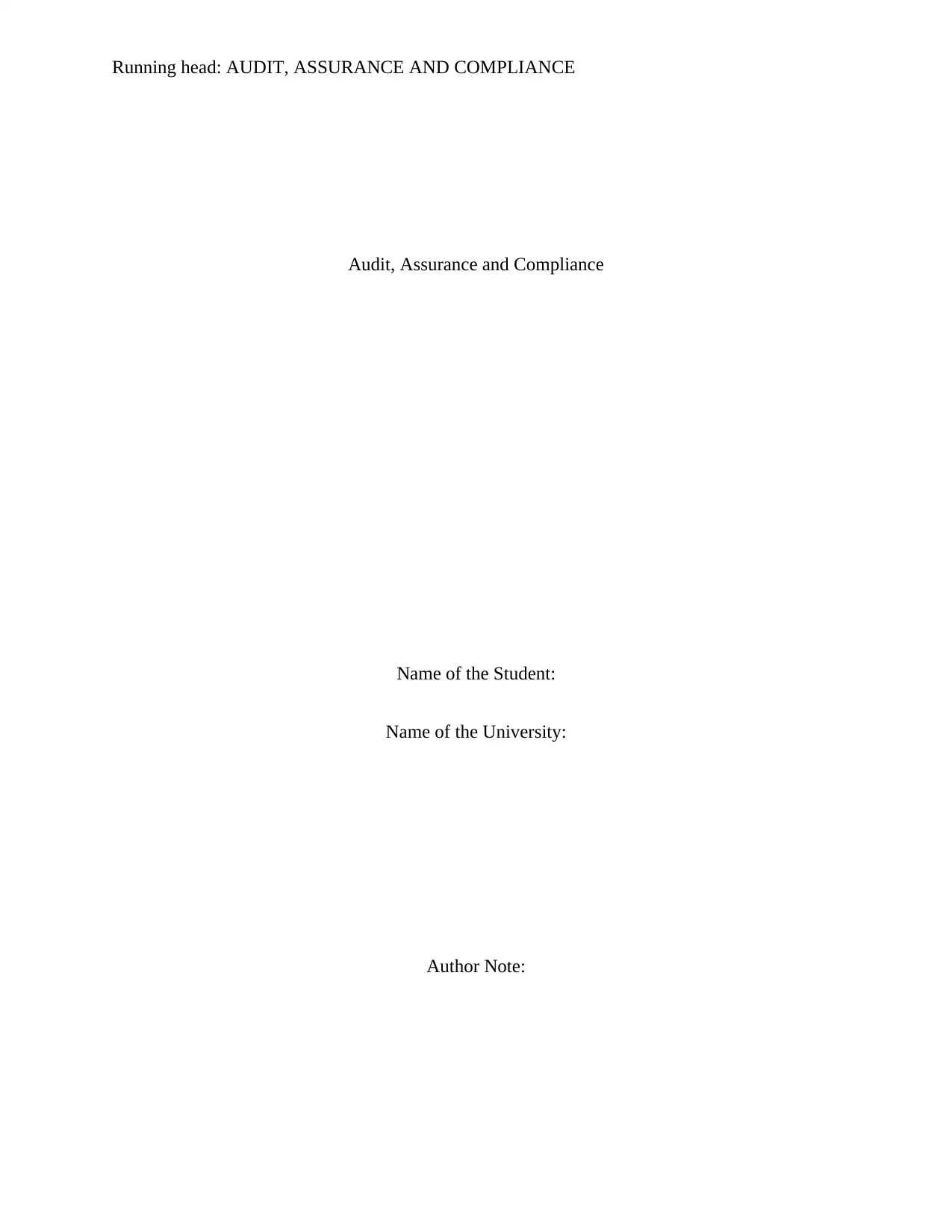
Running head: AUDIT, ASSURANCE AND COMPLIANCE
Audit, Assurance and Compliance
Name of the Student:
Name of the University:
Author Note:
Audit, Assurance and Compliance
Name of the Student:
Name of the University:
Author Note:
Paraphrase This Document
Need a fresh take? Get an instant paraphrase of this document with our AI Paraphraser
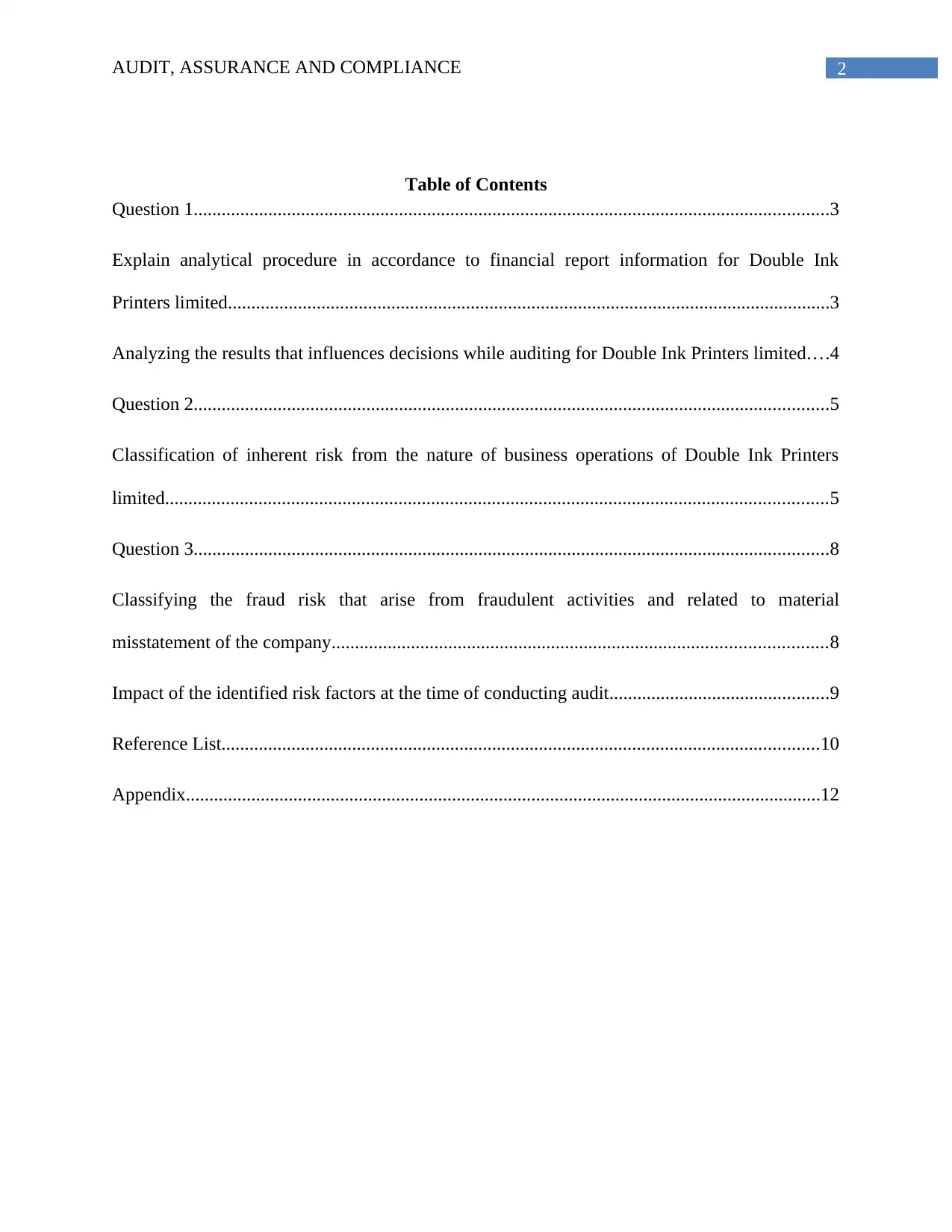
2AUDIT, ASSURANCE AND COMPLIANCE
Table of Contents
Question 1........................................................................................................................................3
Explain analytical procedure in accordance to financial report information for Double Ink
Printers limited.................................................................................................................................3
Analyzing the results that influences decisions while auditing for Double Ink Printers limited....4
Question 2........................................................................................................................................5
Classification of inherent risk from the nature of business operations of Double Ink Printers
limited..............................................................................................................................................5
Question 3........................................................................................................................................8
Classifying the fraud risk that arise from fraudulent activities and related to material
misstatement of the company..........................................................................................................8
Impact of the identified risk factors at the time of conducting audit...............................................9
Reference List................................................................................................................................10
Appendix........................................................................................................................................12
Table of Contents
Question 1........................................................................................................................................3
Explain analytical procedure in accordance to financial report information for Double Ink
Printers limited.................................................................................................................................3
Analyzing the results that influences decisions while auditing for Double Ink Printers limited....4
Question 2........................................................................................................................................5
Classification of inherent risk from the nature of business operations of Double Ink Printers
limited..............................................................................................................................................5
Question 3........................................................................................................................................8
Classifying the fraud risk that arise from fraudulent activities and related to material
misstatement of the company..........................................................................................................8
Impact of the identified risk factors at the time of conducting audit...............................................9
Reference List................................................................................................................................10
Appendix........................................................................................................................................12
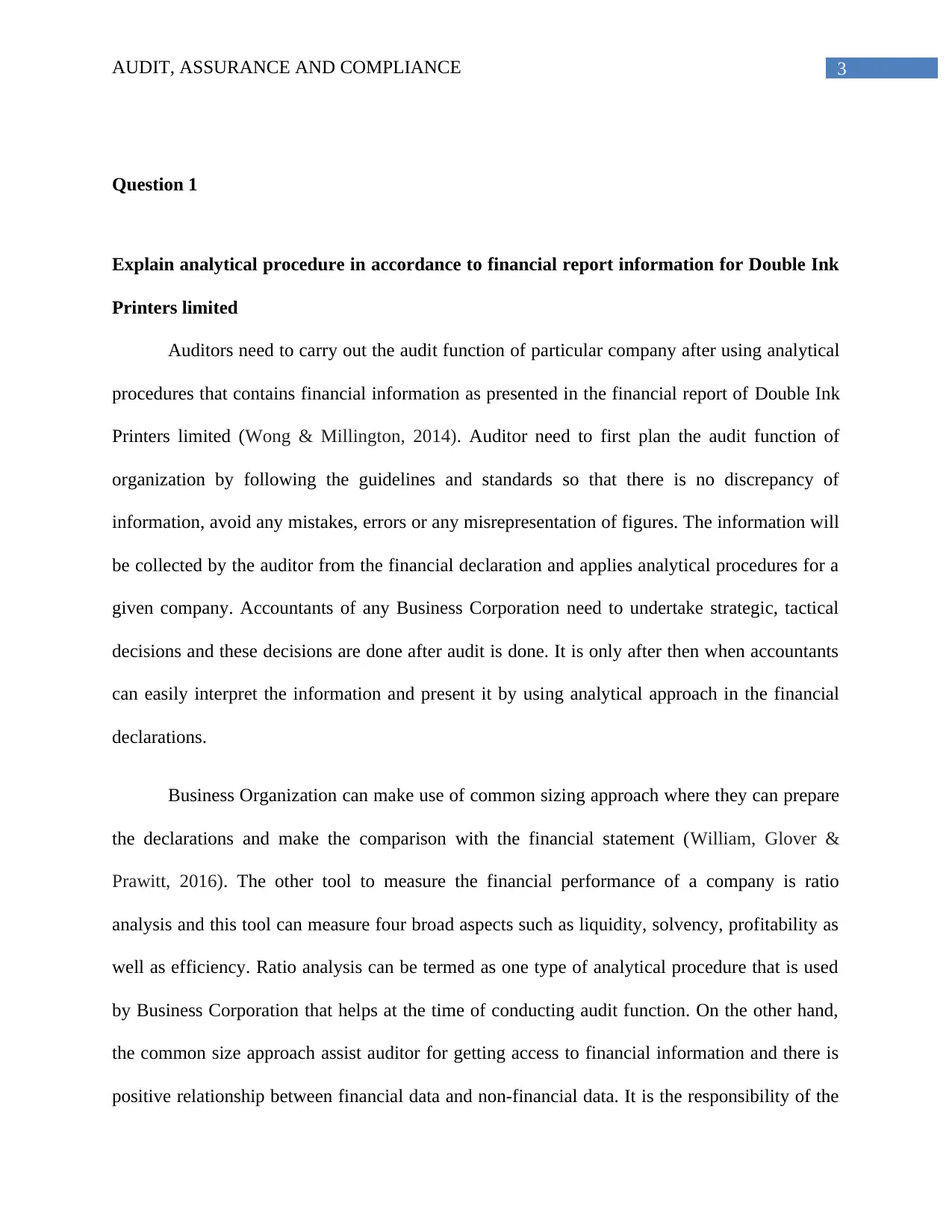
3AUDIT, ASSURANCE AND COMPLIANCE
Question 1
Explain analytical procedure in accordance to financial report information for Double Ink
Printers limited
Auditors need to carry out the audit function of particular company after using analytical
procedures that contains financial information as presented in the financial report of Double Ink
Printers limited (Wong & Millington, 2014). Auditor need to first plan the audit function of
organization by following the guidelines and standards so that there is no discrepancy of
information, avoid any mistakes, errors or any misrepresentation of figures. The information will
be collected by the auditor from the financial declaration and applies analytical procedures for a
given company. Accountants of any Business Corporation need to undertake strategic, tactical
decisions and these decisions are done after audit is done. It is only after then when accountants
can easily interpret the information and present it by using analytical approach in the financial
declarations.
Business Organization can make use of common sizing approach where they can prepare
the declarations and make the comparison with the financial statement (William, Glover &
Prawitt, 2016). The other tool to measure the financial performance of a company is ratio
analysis and this tool can measure four broad aspects such as liquidity, solvency, profitability as
well as efficiency. Ratio analysis can be termed as one type of analytical procedure that is used
by Business Corporation that helps at the time of conducting audit function. On the other hand,
the common size approach assist auditor for getting access to financial information and there is
positive relationship between financial data and non-financial data. It is the responsibility of the
Question 1
Explain analytical procedure in accordance to financial report information for Double Ink
Printers limited
Auditors need to carry out the audit function of particular company after using analytical
procedures that contains financial information as presented in the financial report of Double Ink
Printers limited (Wong & Millington, 2014). Auditor need to first plan the audit function of
organization by following the guidelines and standards so that there is no discrepancy of
information, avoid any mistakes, errors or any misrepresentation of figures. The information will
be collected by the auditor from the financial declaration and applies analytical procedures for a
given company. Accountants of any Business Corporation need to undertake strategic, tactical
decisions and these decisions are done after audit is done. It is only after then when accountants
can easily interpret the information and present it by using analytical approach in the financial
declarations.
Business Organization can make use of common sizing approach where they can prepare
the declarations and make the comparison with the financial statement (William, Glover &
Prawitt, 2016). The other tool to measure the financial performance of a company is ratio
analysis and this tool can measure four broad aspects such as liquidity, solvency, profitability as
well as efficiency. Ratio analysis can be termed as one type of analytical procedure that is used
by Business Corporation that helps at the time of conducting audit function. On the other hand,
the common size approach assist auditor for getting access to financial information and there is
positive relationship between financial data and non-financial data. It is the responsibility of the
⊘ This is a preview!⊘
Do you want full access?
Subscribe today to unlock all pages.

Trusted by 1+ million students worldwide
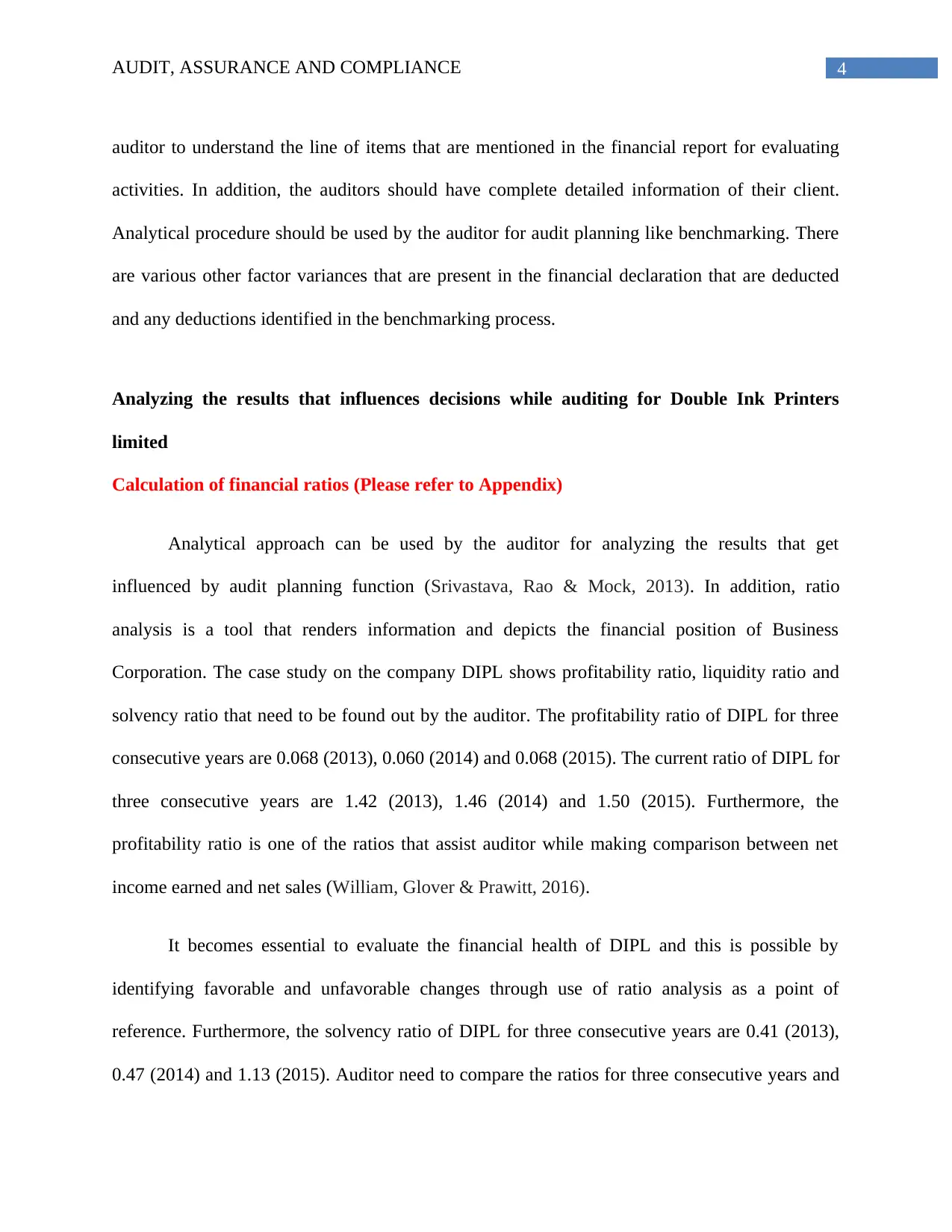
4AUDIT, ASSURANCE AND COMPLIANCE
auditor to understand the line of items that are mentioned in the financial report for evaluating
activities. In addition, the auditors should have complete detailed information of their client.
Analytical procedure should be used by the auditor for audit planning like benchmarking. There
are various other factor variances that are present in the financial declaration that are deducted
and any deductions identified in the benchmarking process.
Analyzing the results that influences decisions while auditing for Double Ink Printers
limited
Calculation of financial ratios (Please refer to Appendix)
Analytical approach can be used by the auditor for analyzing the results that get
influenced by audit planning function (Srivastava, Rao & Mock, 2013). In addition, ratio
analysis is a tool that renders information and depicts the financial position of Business
Corporation. The case study on the company DIPL shows profitability ratio, liquidity ratio and
solvency ratio that need to be found out by the auditor. The profitability ratio of DIPL for three
consecutive years are 0.068 (2013), 0.060 (2014) and 0.068 (2015). The current ratio of DIPL for
three consecutive years are 1.42 (2013), 1.46 (2014) and 1.50 (2015). Furthermore, the
profitability ratio is one of the ratios that assist auditor while making comparison between net
income earned and net sales (William, Glover & Prawitt, 2016).
It becomes essential to evaluate the financial health of DIPL and this is possible by
identifying favorable and unfavorable changes through use of ratio analysis as a point of
reference. Furthermore, the solvency ratio of DIPL for three consecutive years are 0.41 (2013),
0.47 (2014) and 1.13 (2015). Auditor need to compare the ratios for three consecutive years and
auditor to understand the line of items that are mentioned in the financial report for evaluating
activities. In addition, the auditors should have complete detailed information of their client.
Analytical procedure should be used by the auditor for audit planning like benchmarking. There
are various other factor variances that are present in the financial declaration that are deducted
and any deductions identified in the benchmarking process.
Analyzing the results that influences decisions while auditing for Double Ink Printers
limited
Calculation of financial ratios (Please refer to Appendix)
Analytical approach can be used by the auditor for analyzing the results that get
influenced by audit planning function (Srivastava, Rao & Mock, 2013). In addition, ratio
analysis is a tool that renders information and depicts the financial position of Business
Corporation. The case study on the company DIPL shows profitability ratio, liquidity ratio and
solvency ratio that need to be found out by the auditor. The profitability ratio of DIPL for three
consecutive years are 0.068 (2013), 0.060 (2014) and 0.068 (2015). The current ratio of DIPL for
three consecutive years are 1.42 (2013), 1.46 (2014) and 1.50 (2015). Furthermore, the
profitability ratio is one of the ratios that assist auditor while making comparison between net
income earned and net sales (William, Glover & Prawitt, 2016).
It becomes essential to evaluate the financial health of DIPL and this is possible by
identifying favorable and unfavorable changes through use of ratio analysis as a point of
reference. Furthermore, the solvency ratio of DIPL for three consecutive years are 0.41 (2013),
0.47 (2014) and 1.13 (2015). Auditor need to compare the ratios for three consecutive years and
Paraphrase This Document
Need a fresh take? Get an instant paraphrase of this document with our AI Paraphraser
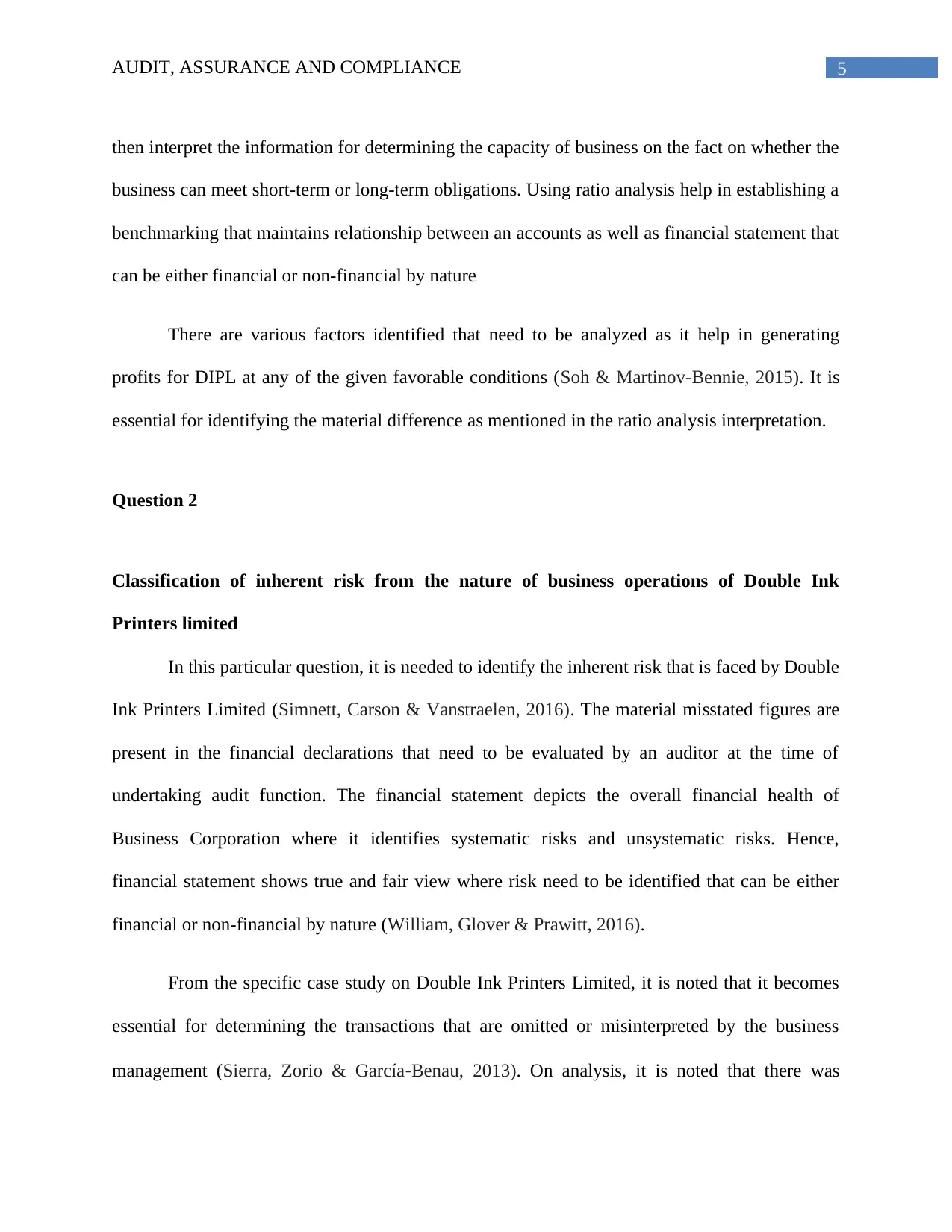
5AUDIT, ASSURANCE AND COMPLIANCE
then interpret the information for determining the capacity of business on the fact on whether the
business can meet short-term or long-term obligations. Using ratio analysis help in establishing a
benchmarking that maintains relationship between an accounts as well as financial statement that
can be either financial or non-financial by nature
There are various factors identified that need to be analyzed as it help in generating
profits for DIPL at any of the given favorable conditions (Soh & Martinov-Bennie, 2015). It is
essential for identifying the material difference as mentioned in the ratio analysis interpretation.
Question 2
Classification of inherent risk from the nature of business operations of Double Ink
Printers limited
In this particular question, it is needed to identify the inherent risk that is faced by Double
Ink Printers Limited (Simnett, Carson & Vanstraelen, 2016). The material misstated figures are
present in the financial declarations that need to be evaluated by an auditor at the time of
undertaking audit function. The financial statement depicts the overall financial health of
Business Corporation where it identifies systematic risks and unsystematic risks. Hence,
financial statement shows true and fair view where risk need to be identified that can be either
financial or non-financial by nature (William, Glover & Prawitt, 2016).
From the specific case study on Double Ink Printers Limited, it is noted that it becomes
essential for determining the transactions that are omitted or misinterpreted by the business
management (Sierra, Zorio & García‐Benau, 2013). On analysis, it is noted that there was
then interpret the information for determining the capacity of business on the fact on whether the
business can meet short-term or long-term obligations. Using ratio analysis help in establishing a
benchmarking that maintains relationship between an accounts as well as financial statement that
can be either financial or non-financial by nature
There are various factors identified that need to be analyzed as it help in generating
profits for DIPL at any of the given favorable conditions (Soh & Martinov-Bennie, 2015). It is
essential for identifying the material difference as mentioned in the ratio analysis interpretation.
Question 2
Classification of inherent risk from the nature of business operations of Double Ink
Printers limited
In this particular question, it is needed to identify the inherent risk that is faced by Double
Ink Printers Limited (Simnett, Carson & Vanstraelen, 2016). The material misstated figures are
present in the financial declarations that need to be evaluated by an auditor at the time of
undertaking audit function. The financial statement depicts the overall financial health of
Business Corporation where it identifies systematic risks and unsystematic risks. Hence,
financial statement shows true and fair view where risk need to be identified that can be either
financial or non-financial by nature (William, Glover & Prawitt, 2016).
From the specific case study on Double Ink Printers Limited, it is noted that it becomes
essential for determining the transactions that are omitted or misinterpreted by the business
management (Sierra, Zorio & García‐Benau, 2013). On analysis, it is noted that there was
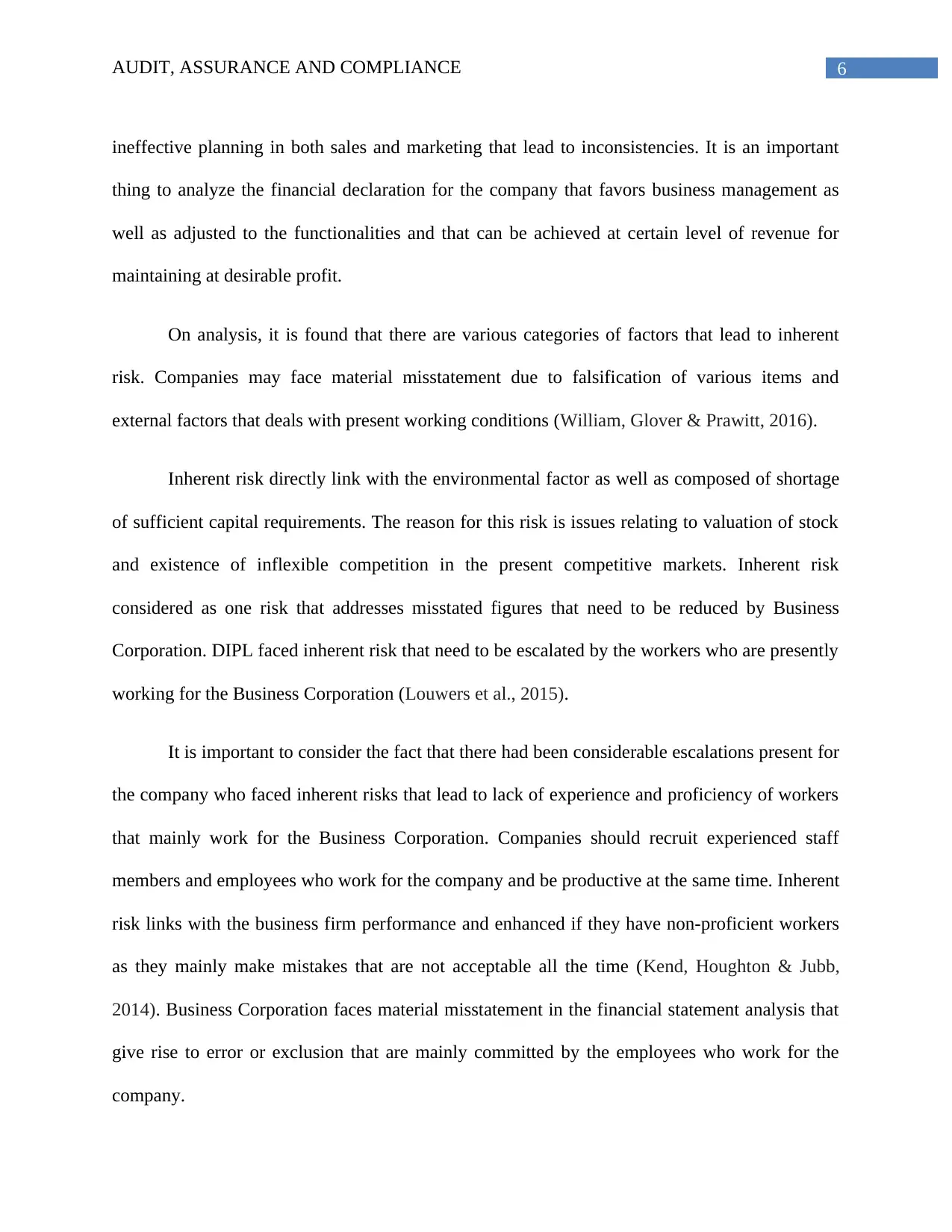
6AUDIT, ASSURANCE AND COMPLIANCE
ineffective planning in both sales and marketing that lead to inconsistencies. It is an important
thing to analyze the financial declaration for the company that favors business management as
well as adjusted to the functionalities and that can be achieved at certain level of revenue for
maintaining at desirable profit.
On analysis, it is found that there are various categories of factors that lead to inherent
risk. Companies may face material misstatement due to falsification of various items and
external factors that deals with present working conditions (William, Glover & Prawitt, 2016).
Inherent risk directly link with the environmental factor as well as composed of shortage
of sufficient capital requirements. The reason for this risk is issues relating to valuation of stock
and existence of inflexible competition in the present competitive markets. Inherent risk
considered as one risk that addresses misstated figures that need to be reduced by Business
Corporation. DIPL faced inherent risk that need to be escalated by the workers who are presently
working for the Business Corporation (Louwers et al., 2015).
It is important to consider the fact that there had been considerable escalations present for
the company who faced inherent risks that lead to lack of experience and proficiency of workers
that mainly work for the Business Corporation. Companies should recruit experienced staff
members and employees who work for the company and be productive at the same time. Inherent
risk links with the business firm performance and enhanced if they have non-proficient workers
as they mainly make mistakes that are not acceptable all the time (Kend, Houghton & Jubb,
2014). Business Corporation faces material misstatement in the financial statement analysis that
give rise to error or exclusion that are mainly committed by the employees who work for the
company.
ineffective planning in both sales and marketing that lead to inconsistencies. It is an important
thing to analyze the financial declaration for the company that favors business management as
well as adjusted to the functionalities and that can be achieved at certain level of revenue for
maintaining at desirable profit.
On analysis, it is found that there are various categories of factors that lead to inherent
risk. Companies may face material misstatement due to falsification of various items and
external factors that deals with present working conditions (William, Glover & Prawitt, 2016).
Inherent risk directly link with the environmental factor as well as composed of shortage
of sufficient capital requirements. The reason for this risk is issues relating to valuation of stock
and existence of inflexible competition in the present competitive markets. Inherent risk
considered as one risk that addresses misstated figures that need to be reduced by Business
Corporation. DIPL faced inherent risk that need to be escalated by the workers who are presently
working for the Business Corporation (Louwers et al., 2015).
It is important to consider the fact that there had been considerable escalations present for
the company who faced inherent risks that lead to lack of experience and proficiency of workers
that mainly work for the Business Corporation. Companies should recruit experienced staff
members and employees who work for the company and be productive at the same time. Inherent
risk links with the business firm performance and enhanced if they have non-proficient workers
as they mainly make mistakes that are not acceptable all the time (Kend, Houghton & Jubb,
2014). Business Corporation faces material misstatement in the financial statement analysis that
give rise to error or exclusion that are mainly committed by the employees who work for the
company.
⊘ This is a preview!⊘
Do you want full access?
Subscribe today to unlock all pages.

Trusted by 1+ million students worldwide
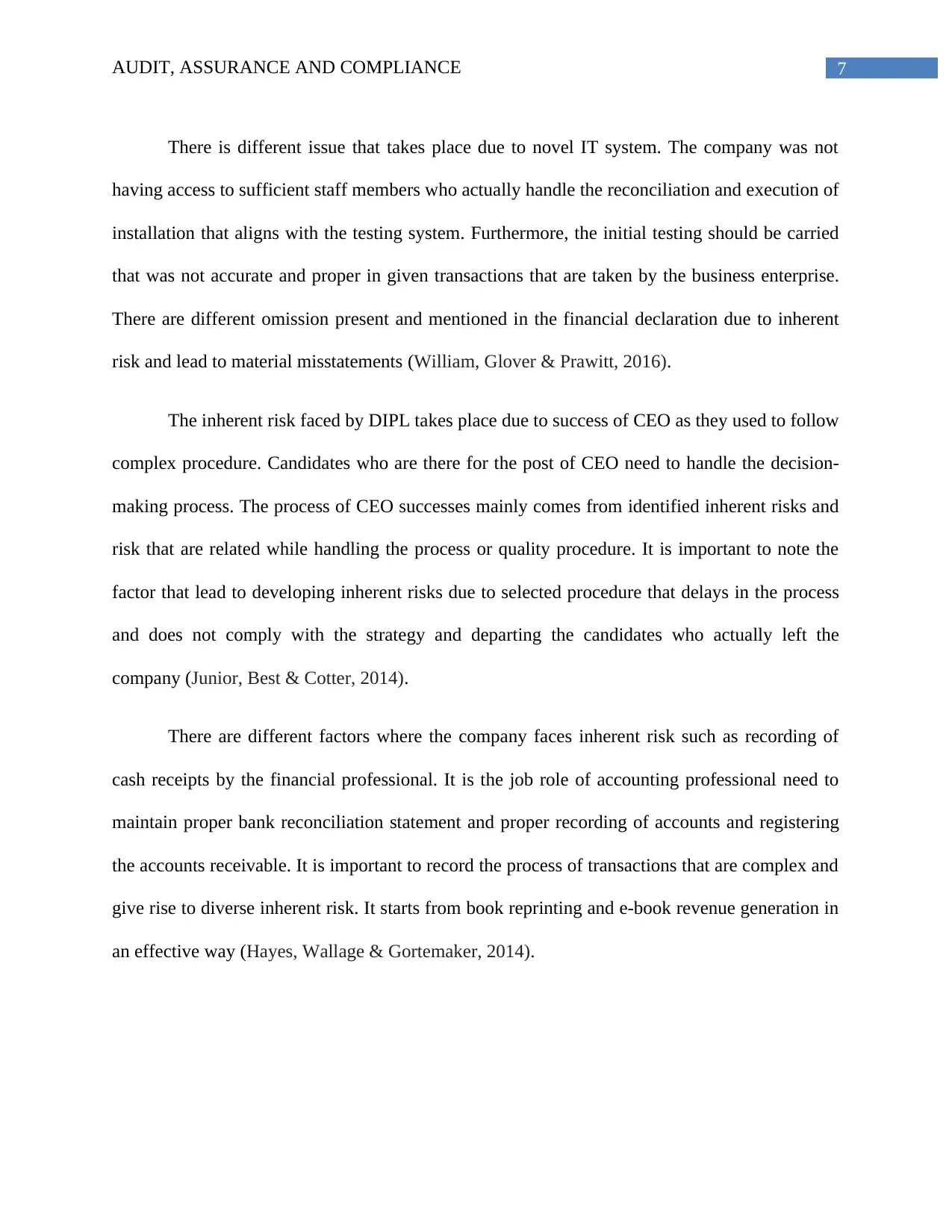
7AUDIT, ASSURANCE AND COMPLIANCE
There is different issue that takes place due to novel IT system. The company was not
having access to sufficient staff members who actually handle the reconciliation and execution of
installation that aligns with the testing system. Furthermore, the initial testing should be carried
that was not accurate and proper in given transactions that are taken by the business enterprise.
There are different omission present and mentioned in the financial declaration due to inherent
risk and lead to material misstatements (William, Glover & Prawitt, 2016).
The inherent risk faced by DIPL takes place due to success of CEO as they used to follow
complex procedure. Candidates who are there for the post of CEO need to handle the decision-
making process. The process of CEO successes mainly comes from identified inherent risks and
risk that are related while handling the process or quality procedure. It is important to note the
factor that lead to developing inherent risks due to selected procedure that delays in the process
and does not comply with the strategy and departing the candidates who actually left the
company (Junior, Best & Cotter, 2014).
There are different factors where the company faces inherent risk such as recording of
cash receipts by the financial professional. It is the job role of accounting professional need to
maintain proper bank reconciliation statement and proper recording of accounts and registering
the accounts receivable. It is important to record the process of transactions that are complex and
give rise to diverse inherent risk. It starts from book reprinting and e-book revenue generation in
an effective way (Hayes, Wallage & Gortemaker, 2014).
There is different issue that takes place due to novel IT system. The company was not
having access to sufficient staff members who actually handle the reconciliation and execution of
installation that aligns with the testing system. Furthermore, the initial testing should be carried
that was not accurate and proper in given transactions that are taken by the business enterprise.
There are different omission present and mentioned in the financial declaration due to inherent
risk and lead to material misstatements (William, Glover & Prawitt, 2016).
The inherent risk faced by DIPL takes place due to success of CEO as they used to follow
complex procedure. Candidates who are there for the post of CEO need to handle the decision-
making process. The process of CEO successes mainly comes from identified inherent risks and
risk that are related while handling the process or quality procedure. It is important to note the
factor that lead to developing inherent risks due to selected procedure that delays in the process
and does not comply with the strategy and departing the candidates who actually left the
company (Junior, Best & Cotter, 2014).
There are different factors where the company faces inherent risk such as recording of
cash receipts by the financial professional. It is the job role of accounting professional need to
maintain proper bank reconciliation statement and proper recording of accounts and registering
the accounts receivable. It is important to record the process of transactions that are complex and
give rise to diverse inherent risk. It starts from book reprinting and e-book revenue generation in
an effective way (Hayes, Wallage & Gortemaker, 2014).
Paraphrase This Document
Need a fresh take? Get an instant paraphrase of this document with our AI Paraphraser
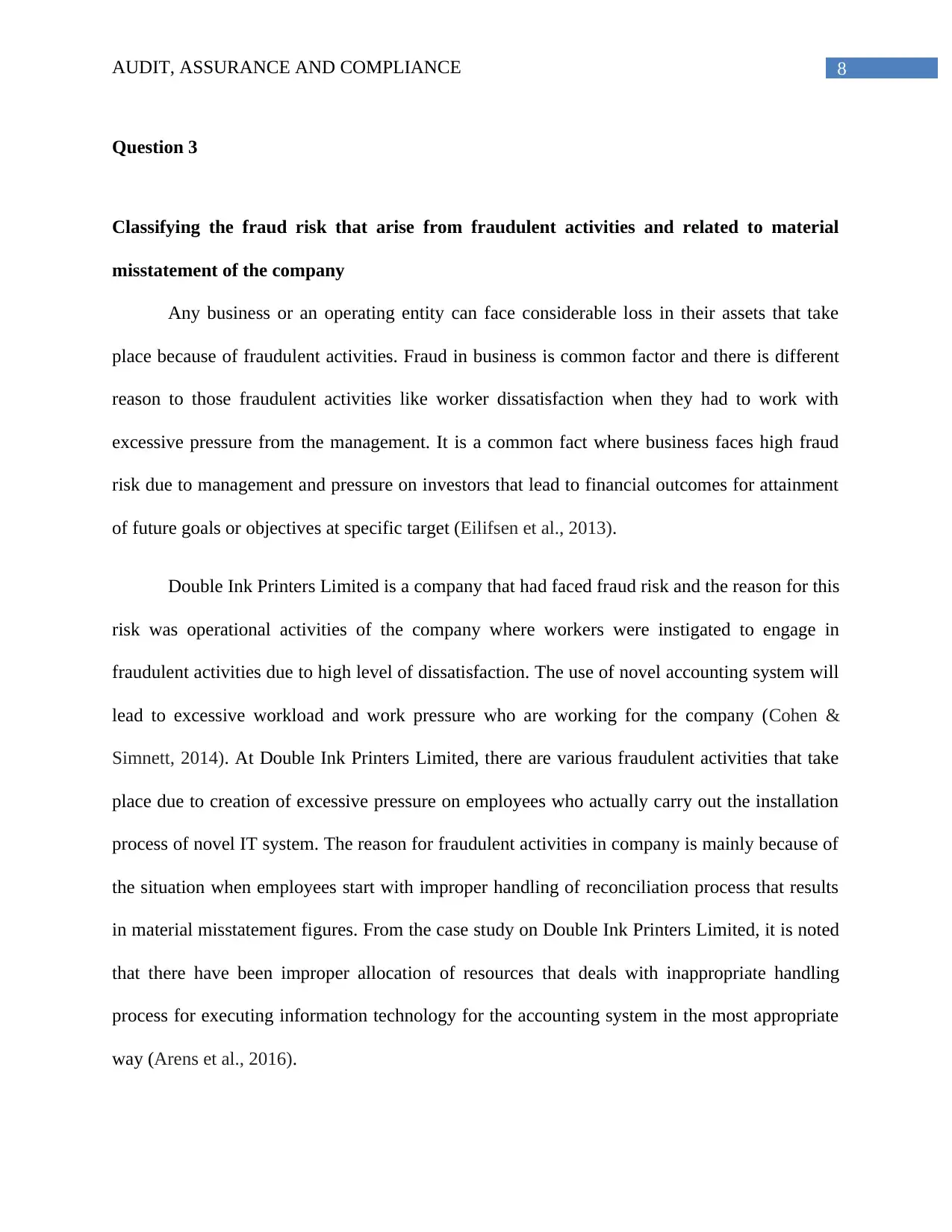
8AUDIT, ASSURANCE AND COMPLIANCE
Question 3
Classifying the fraud risk that arise from fraudulent activities and related to material
misstatement of the company
Any business or an operating entity can face considerable loss in their assets that take
place because of fraudulent activities. Fraud in business is common factor and there is different
reason to those fraudulent activities like worker dissatisfaction when they had to work with
excessive pressure from the management. It is a common fact where business faces high fraud
risk due to management and pressure on investors that lead to financial outcomes for attainment
of future goals or objectives at specific target (Eilifsen et al., 2013).
Double Ink Printers Limited is a company that had faced fraud risk and the reason for this
risk was operational activities of the company where workers were instigated to engage in
fraudulent activities due to high level of dissatisfaction. The use of novel accounting system will
lead to excessive workload and work pressure who are working for the company (Cohen &
Simnett, 2014). At Double Ink Printers Limited, there are various fraudulent activities that take
place due to creation of excessive pressure on employees who actually carry out the installation
process of novel IT system. The reason for fraudulent activities in company is mainly because of
the situation when employees start with improper handling of reconciliation process that results
in material misstatement figures. From the case study on Double Ink Printers Limited, it is noted
that there have been improper allocation of resources that deals with inappropriate handling
process for executing information technology for the accounting system in the most appropriate
way (Arens et al., 2016).
Question 3
Classifying the fraud risk that arise from fraudulent activities and related to material
misstatement of the company
Any business or an operating entity can face considerable loss in their assets that take
place because of fraudulent activities. Fraud in business is common factor and there is different
reason to those fraudulent activities like worker dissatisfaction when they had to work with
excessive pressure from the management. It is a common fact where business faces high fraud
risk due to management and pressure on investors that lead to financial outcomes for attainment
of future goals or objectives at specific target (Eilifsen et al., 2013).
Double Ink Printers Limited is a company that had faced fraud risk and the reason for this
risk was operational activities of the company where workers were instigated to engage in
fraudulent activities due to high level of dissatisfaction. The use of novel accounting system will
lead to excessive workload and work pressure who are working for the company (Cohen &
Simnett, 2014). At Double Ink Printers Limited, there are various fraudulent activities that take
place due to creation of excessive pressure on employees who actually carry out the installation
process of novel IT system. The reason for fraudulent activities in company is mainly because of
the situation when employees start with improper handling of reconciliation process that results
in material misstatement figures. From the case study on Double Ink Printers Limited, it is noted
that there have been improper allocation of resources that deals with inappropriate handling
process for executing information technology for the accounting system in the most appropriate
way (Arens et al., 2016).
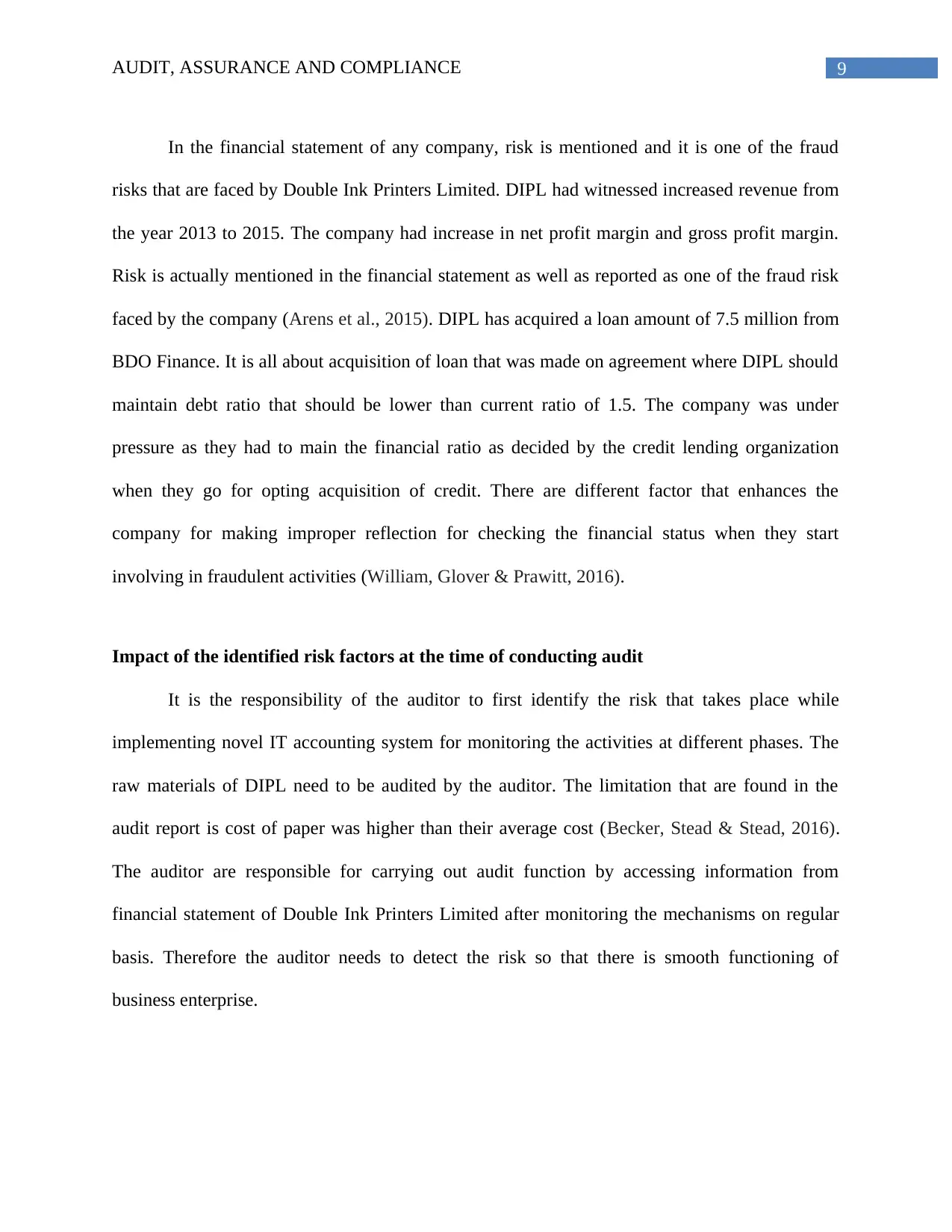
9AUDIT, ASSURANCE AND COMPLIANCE
In the financial statement of any company, risk is mentioned and it is one of the fraud
risks that are faced by Double Ink Printers Limited. DIPL had witnessed increased revenue from
the year 2013 to 2015. The company had increase in net profit margin and gross profit margin.
Risk is actually mentioned in the financial statement as well as reported as one of the fraud risk
faced by the company (Arens et al., 2015). DIPL has acquired a loan amount of 7.5 million from
BDO Finance. It is all about acquisition of loan that was made on agreement where DIPL should
maintain debt ratio that should be lower than current ratio of 1.5. The company was under
pressure as they had to main the financial ratio as decided by the credit lending organization
when they go for opting acquisition of credit. There are different factor that enhances the
company for making improper reflection for checking the financial status when they start
involving in fraudulent activities (William, Glover & Prawitt, 2016).
Impact of the identified risk factors at the time of conducting audit
It is the responsibility of the auditor to first identify the risk that takes place while
implementing novel IT accounting system for monitoring the activities at different phases. The
raw materials of DIPL need to be audited by the auditor. The limitation that are found in the
audit report is cost of paper was higher than their average cost (Becker, Stead & Stead, 2016).
The auditor are responsible for carrying out audit function by accessing information from
financial statement of Double Ink Printers Limited after monitoring the mechanisms on regular
basis. Therefore the auditor needs to detect the risk so that there is smooth functioning of
business enterprise.
In the financial statement of any company, risk is mentioned and it is one of the fraud
risks that are faced by Double Ink Printers Limited. DIPL had witnessed increased revenue from
the year 2013 to 2015. The company had increase in net profit margin and gross profit margin.
Risk is actually mentioned in the financial statement as well as reported as one of the fraud risk
faced by the company (Arens et al., 2015). DIPL has acquired a loan amount of 7.5 million from
BDO Finance. It is all about acquisition of loan that was made on agreement where DIPL should
maintain debt ratio that should be lower than current ratio of 1.5. The company was under
pressure as they had to main the financial ratio as decided by the credit lending organization
when they go for opting acquisition of credit. There are different factor that enhances the
company for making improper reflection for checking the financial status when they start
involving in fraudulent activities (William, Glover & Prawitt, 2016).
Impact of the identified risk factors at the time of conducting audit
It is the responsibility of the auditor to first identify the risk that takes place while
implementing novel IT accounting system for monitoring the activities at different phases. The
raw materials of DIPL need to be audited by the auditor. The limitation that are found in the
audit report is cost of paper was higher than their average cost (Becker, Stead & Stead, 2016).
The auditor are responsible for carrying out audit function by accessing information from
financial statement of Double Ink Printers Limited after monitoring the mechanisms on regular
basis. Therefore the auditor needs to detect the risk so that there is smooth functioning of
business enterprise.
⊘ This is a preview!⊘
Do you want full access?
Subscribe today to unlock all pages.

Trusted by 1+ million students worldwide
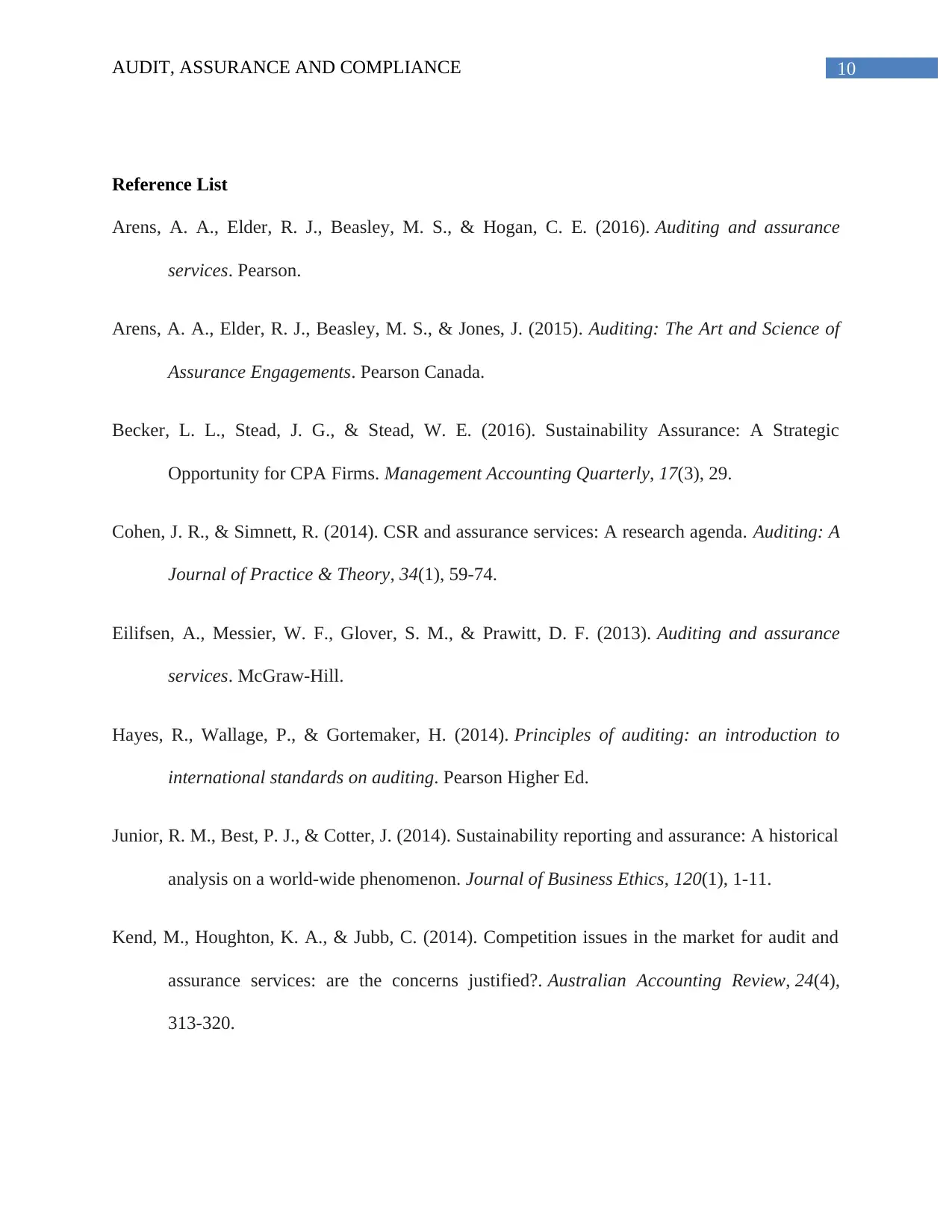
10AUDIT, ASSURANCE AND COMPLIANCE
Reference List
Arens, A. A., Elder, R. J., Beasley, M. S., & Hogan, C. E. (2016). Auditing and assurance
services. Pearson.
Arens, A. A., Elder, R. J., Beasley, M. S., & Jones, J. (2015). Auditing: The Art and Science of
Assurance Engagements. Pearson Canada.
Becker, L. L., Stead, J. G., & Stead, W. E. (2016). Sustainability Assurance: A Strategic
Opportunity for CPA Firms. Management Accounting Quarterly, 17(3), 29.
Cohen, J. R., & Simnett, R. (2014). CSR and assurance services: A research agenda. Auditing: A
Journal of Practice & Theory, 34(1), 59-74.
Eilifsen, A., Messier, W. F., Glover, S. M., & Prawitt, D. F. (2013). Auditing and assurance
services. McGraw-Hill.
Hayes, R., Wallage, P., & Gortemaker, H. (2014). Principles of auditing: an introduction to
international standards on auditing. Pearson Higher Ed.
Junior, R. M., Best, P. J., & Cotter, J. (2014). Sustainability reporting and assurance: A historical
analysis on a world-wide phenomenon. Journal of Business Ethics, 120(1), 1-11.
Kend, M., Houghton, K. A., & Jubb, C. (2014). Competition issues in the market for audit and
assurance services: are the concerns justified?. Australian Accounting Review, 24(4),
313-320.
Reference List
Arens, A. A., Elder, R. J., Beasley, M. S., & Hogan, C. E. (2016). Auditing and assurance
services. Pearson.
Arens, A. A., Elder, R. J., Beasley, M. S., & Jones, J. (2015). Auditing: The Art and Science of
Assurance Engagements. Pearson Canada.
Becker, L. L., Stead, J. G., & Stead, W. E. (2016). Sustainability Assurance: A Strategic
Opportunity for CPA Firms. Management Accounting Quarterly, 17(3), 29.
Cohen, J. R., & Simnett, R. (2014). CSR and assurance services: A research agenda. Auditing: A
Journal of Practice & Theory, 34(1), 59-74.
Eilifsen, A., Messier, W. F., Glover, S. M., & Prawitt, D. F. (2013). Auditing and assurance
services. McGraw-Hill.
Hayes, R., Wallage, P., & Gortemaker, H. (2014). Principles of auditing: an introduction to
international standards on auditing. Pearson Higher Ed.
Junior, R. M., Best, P. J., & Cotter, J. (2014). Sustainability reporting and assurance: A historical
analysis on a world-wide phenomenon. Journal of Business Ethics, 120(1), 1-11.
Kend, M., Houghton, K. A., & Jubb, C. (2014). Competition issues in the market for audit and
assurance services: are the concerns justified?. Australian Accounting Review, 24(4),
313-320.
Paraphrase This Document
Need a fresh take? Get an instant paraphrase of this document with our AI Paraphraser
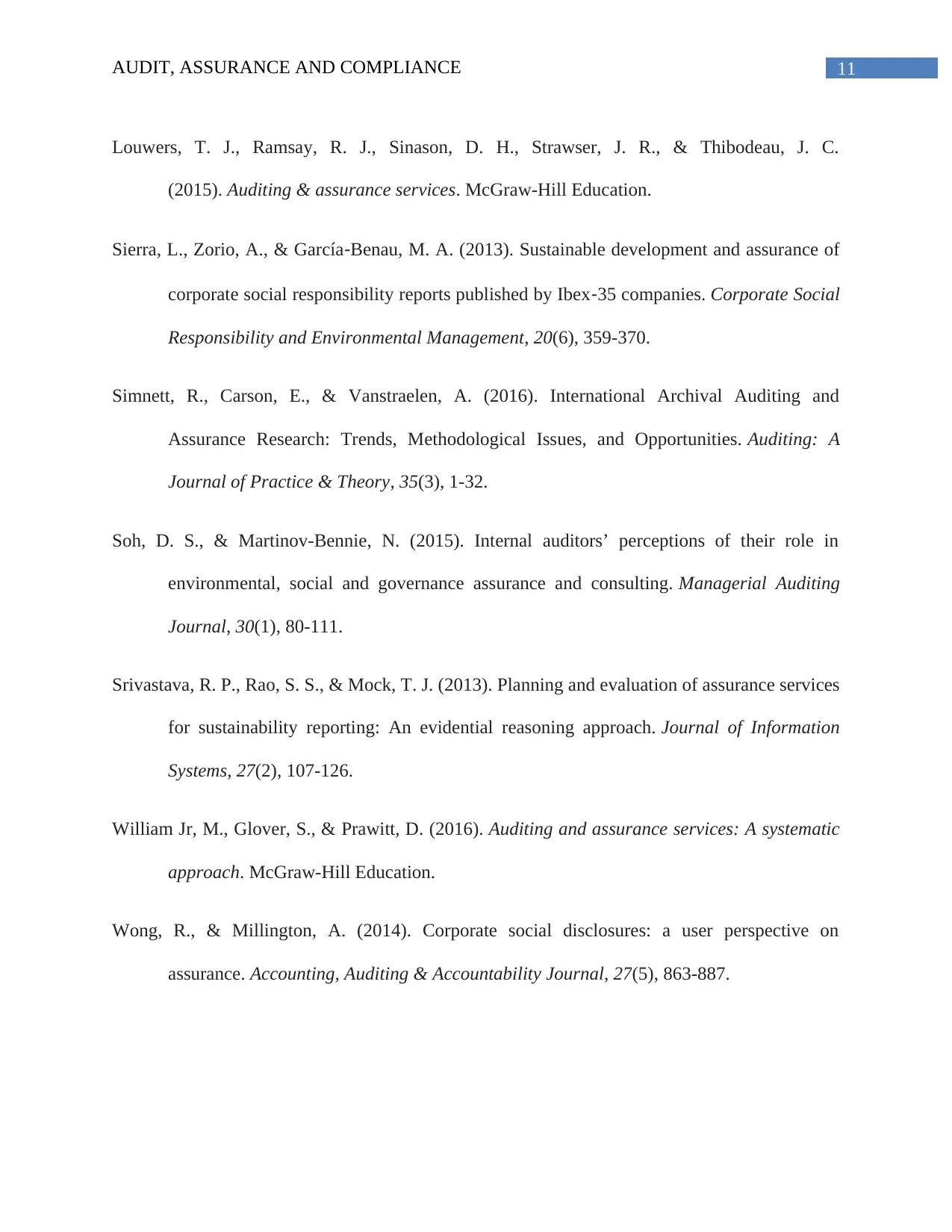
11AUDIT, ASSURANCE AND COMPLIANCE
Louwers, T. J., Ramsay, R. J., Sinason, D. H., Strawser, J. R., & Thibodeau, J. C.
(2015). Auditing & assurance services. McGraw-Hill Education.
Sierra, L., Zorio, A., & García‐Benau, M. A. (2013). Sustainable development and assurance of
corporate social responsibility reports published by Ibex‐35 companies. Corporate Social
Responsibility and Environmental Management, 20(6), 359-370.
Simnett, R., Carson, E., & Vanstraelen, A. (2016). International Archival Auditing and
Assurance Research: Trends, Methodological Issues, and Opportunities. Auditing: A
Journal of Practice & Theory, 35(3), 1-32.
Soh, D. S., & Martinov-Bennie, N. (2015). Internal auditors’ perceptions of their role in
environmental, social and governance assurance and consulting. Managerial Auditing
Journal, 30(1), 80-111.
Srivastava, R. P., Rao, S. S., & Mock, T. J. (2013). Planning and evaluation of assurance services
for sustainability reporting: An evidential reasoning approach. Journal of Information
Systems, 27(2), 107-126.
William Jr, M., Glover, S., & Prawitt, D. (2016). Auditing and assurance services: A systematic
approach. McGraw-Hill Education.
Wong, R., & Millington, A. (2014). Corporate social disclosures: a user perspective on
assurance. Accounting, Auditing & Accountability Journal, 27(5), 863-887.
Louwers, T. J., Ramsay, R. J., Sinason, D. H., Strawser, J. R., & Thibodeau, J. C.
(2015). Auditing & assurance services. McGraw-Hill Education.
Sierra, L., Zorio, A., & García‐Benau, M. A. (2013). Sustainable development and assurance of
corporate social responsibility reports published by Ibex‐35 companies. Corporate Social
Responsibility and Environmental Management, 20(6), 359-370.
Simnett, R., Carson, E., & Vanstraelen, A. (2016). International Archival Auditing and
Assurance Research: Trends, Methodological Issues, and Opportunities. Auditing: A
Journal of Practice & Theory, 35(3), 1-32.
Soh, D. S., & Martinov-Bennie, N. (2015). Internal auditors’ perceptions of their role in
environmental, social and governance assurance and consulting. Managerial Auditing
Journal, 30(1), 80-111.
Srivastava, R. P., Rao, S. S., & Mock, T. J. (2013). Planning and evaluation of assurance services
for sustainability reporting: An evidential reasoning approach. Journal of Information
Systems, 27(2), 107-126.
William Jr, M., Glover, S., & Prawitt, D. (2016). Auditing and assurance services: A systematic
approach. McGraw-Hill Education.
Wong, R., & Millington, A. (2014). Corporate social disclosures: a user perspective on
assurance. Accounting, Auditing & Accountability Journal, 27(5), 863-887.
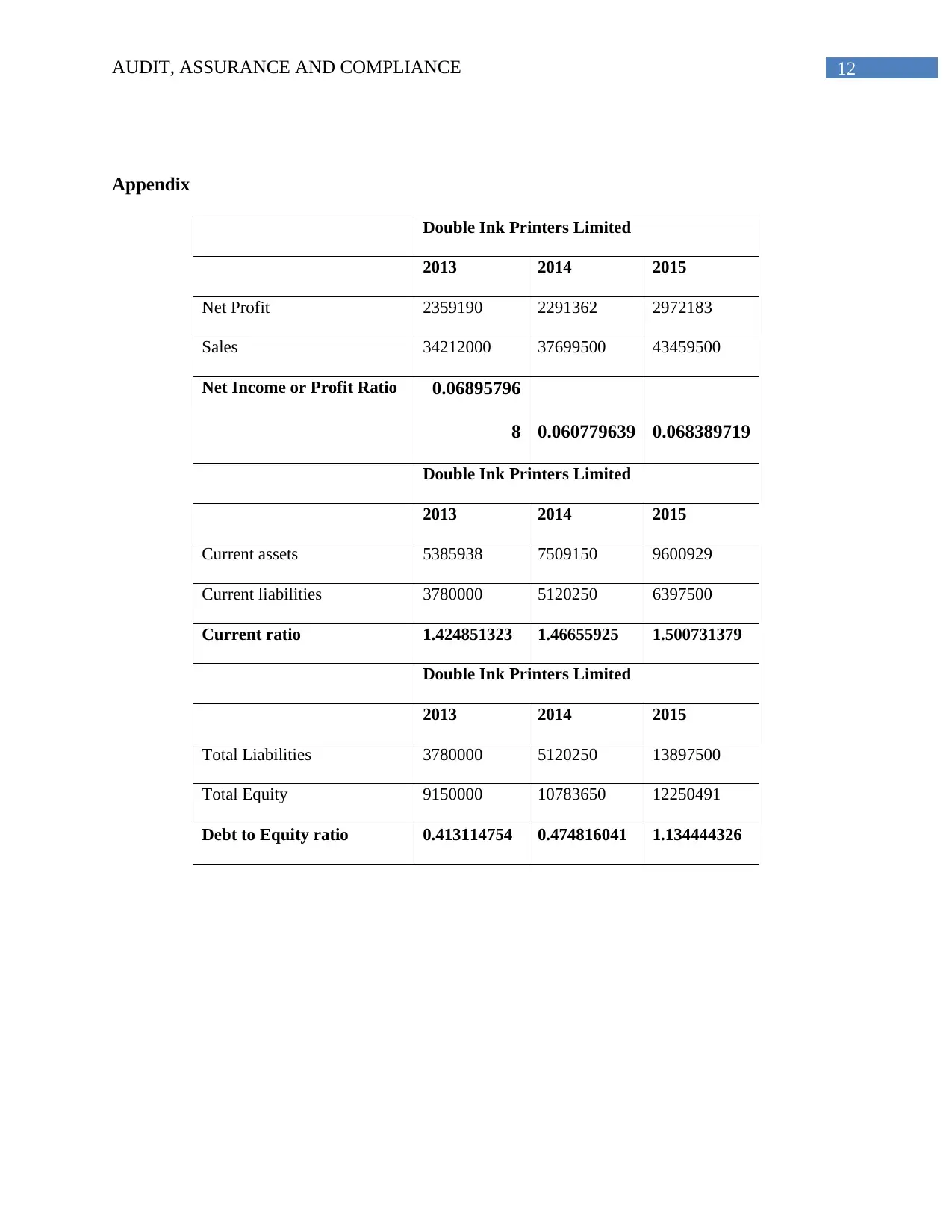
12AUDIT, ASSURANCE AND COMPLIANCE
Appendix
Double Ink Printers Limited
2013 2014 2015
Net Profit 2359190 2291362 2972183
Sales 34212000 37699500 43459500
Net Income or Profit Ratio 0.06895796
8 0.060779639 0.068389719
Double Ink Printers Limited
2013 2014 2015
Current assets 5385938 7509150 9600929
Current liabilities 3780000 5120250 6397500
Current ratio 1.424851323 1.46655925 1.500731379
Double Ink Printers Limited
2013 2014 2015
Total Liabilities 3780000 5120250 13897500
Total Equity 9150000 10783650 12250491
Debt to Equity ratio 0.413114754 0.474816041 1.134444326
Appendix
Double Ink Printers Limited
2013 2014 2015
Net Profit 2359190 2291362 2972183
Sales 34212000 37699500 43459500
Net Income or Profit Ratio 0.06895796
8 0.060779639 0.068389719
Double Ink Printers Limited
2013 2014 2015
Current assets 5385938 7509150 9600929
Current liabilities 3780000 5120250 6397500
Current ratio 1.424851323 1.46655925 1.500731379
Double Ink Printers Limited
2013 2014 2015
Total Liabilities 3780000 5120250 13897500
Total Equity 9150000 10783650 12250491
Debt to Equity ratio 0.413114754 0.474816041 1.134444326
⊘ This is a preview!⊘
Do you want full access?
Subscribe today to unlock all pages.

Trusted by 1+ million students worldwide
1 out of 12
Related Documents
Your All-in-One AI-Powered Toolkit for Academic Success.
+13062052269
info@desklib.com
Available 24*7 on WhatsApp / Email
![[object Object]](/_next/static/media/star-bottom.7253800d.svg)
Unlock your academic potential
Copyright © 2020–2025 A2Z Services. All Rights Reserved. Developed and managed by ZUCOL.





